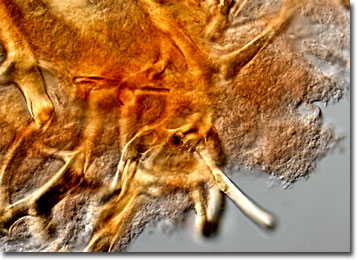Differential Interference Contrast Image Gallery
Sponge Skeleton
Sponges are colonial animals that belong to the phylum Porifera. The primitive invertebrates were some of the earliest multicellular organisms to inhabit the oceans of the earth, fossils indicating that they have been proliferating for at least 600 million years.

Sponges do not naturally exist in the soft, golden form that they exhibit on the shelves of modern bath stores. In fact, sponges grow in a wide array of shapes, sizes, and colors. Some varieties are as small as coins, while other may grow several feet in height. Sponges may be flat, smooth, branching, rough, soft, or prickly. They may also be shaped like cones, spheres, or tubes and colored red, yellow, green, blue, or almost any other color imaginable. Some of the pigments, however, are a result of algae that inhabit the inside of the sponge or that have been consumed by it.
Though sponges may occasionally be detrimental to organisms, many creatures live in symbiosis with them. Sponges are excellent filters, generally passing the equivalent of more than 60 glasses of water through their systems each day, and various aquatic animals exploit them for this characteristic. Also, sponges tend to have an objectionable odor and taste, and some varieties are poisonous as well. Small creatures, such as certain types of hermit crabs, frequently carry sponges to discourage predation, sometimes even using them as camouflage.
